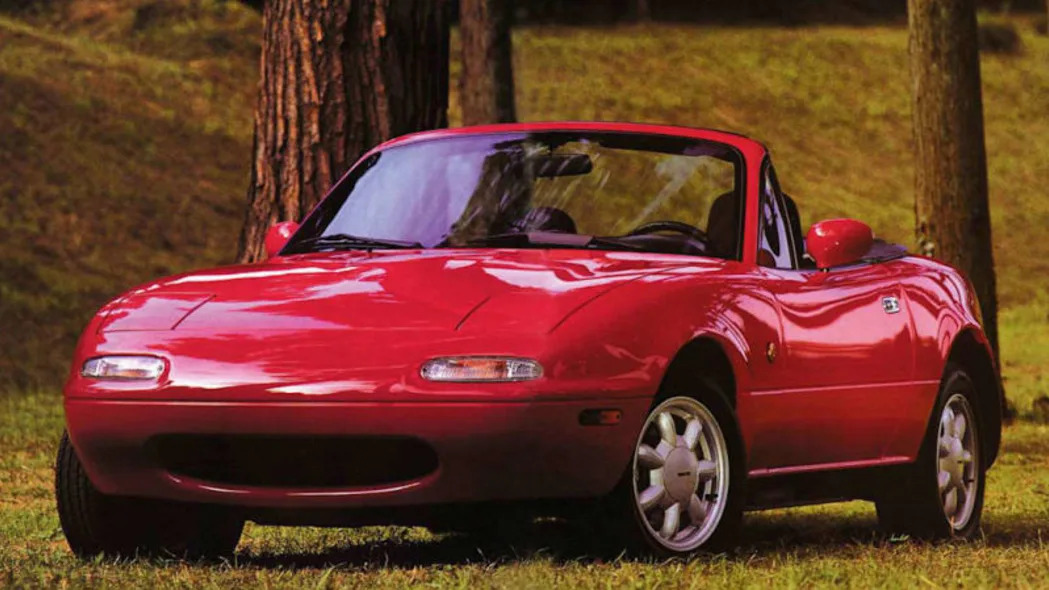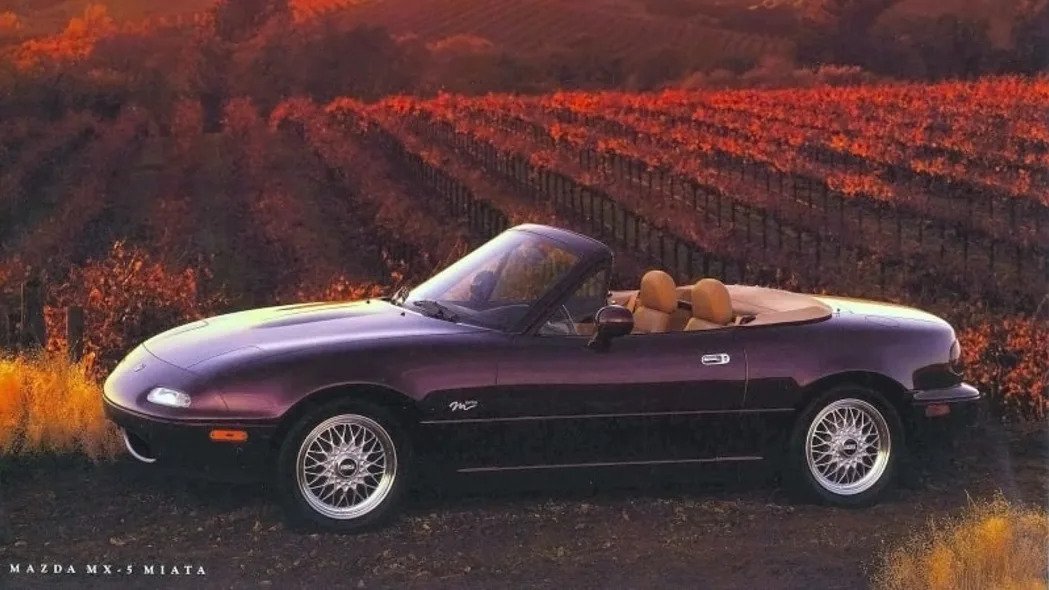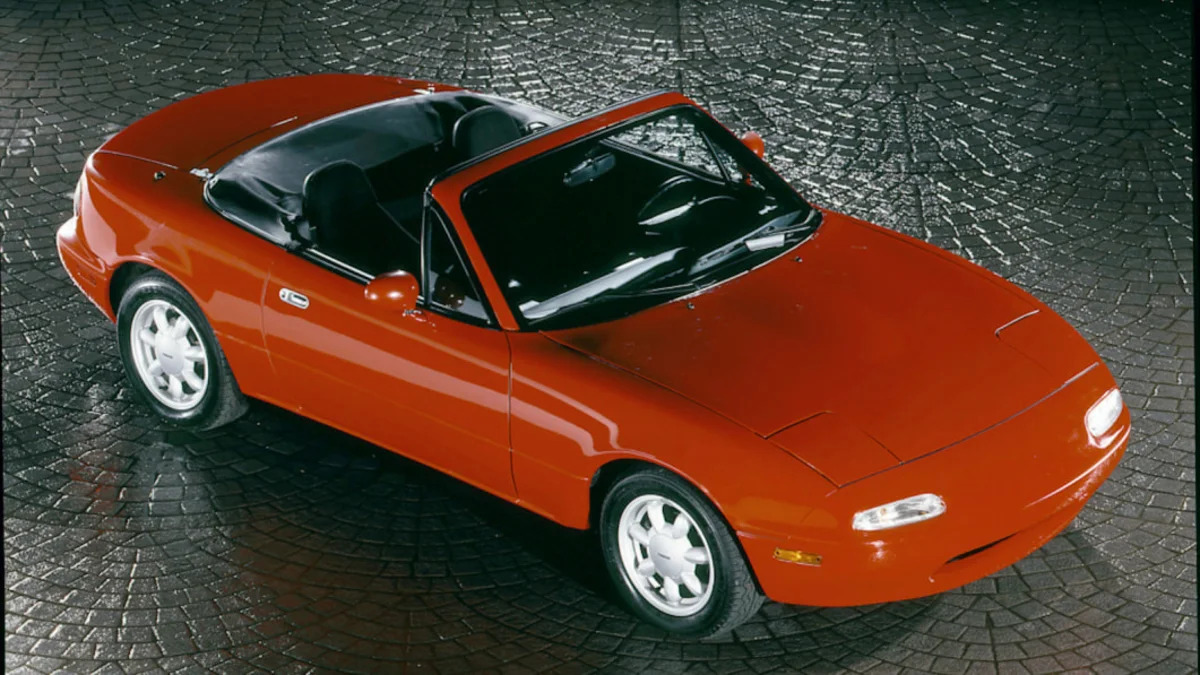If you've spent any amount of time reading car news and reviews from us or any other outlet, you know we all love the Mazda Miata. Two of us at Autoblog own Miatas. And it's all because of some basic things. They're affordable, they're reliable, they're relatively practical, but above all, they're an absolute hoot to drive. Of course, with four generations to pick from, it can be a little tough to decide (though there really aren't any wrong choices with these cars). We've already talked about the biggest and most practical, so this time we'll wind it back to the generation that started it all, typically referred to as the NA.
Read more: 2006-2015 Mazda Miata | Used Vehicle Spotlight
Introduced for the 1990 model year, the Miata was an instant hit with its lightweight and rear-wheel-drive layout. And it offered timeless styling and charming pop-up headlights that still win people over today. This first generation was built through the 1997 model year, and with its large fanbase even today, it's easy to own and maintain them with plenty of parts availability. They're great for modifying, too.
Why the Mazda MX-5 Miata?
As we alluded to in the introduction, you pick a Miata because it's a lot of fun, and in many ways. Of course being a convertible is a lot of fun, especially one that's as open as the Miata. But they drive superbly, too. The NA in particular is the lightest of the Miata generations at just 2,100 pounds, and it has some of the skinniest tires. This makes it easy to throw around in corners, and the fact that it has low enough limits that are easy enough to feel out mean it's exciting and predictable even at low speeds and on public roads. Being such an early model, it has excellent steering feel, even with power steering (yes, many lacked power steering at first).
It has a great powertrain, too. The engine is willing to rev and has a classic growl, which is especially enhanced with an upgraded intake and exhaust, if you're interested in modifying. Power isn't great — between 116 and 133 horsepower depending on the model — but with so little weight, they're still perky cars. If you want more power, there are plenty of forced induction upgrades available for the later 1.8-liter models, or even engine swap kits if you really want to get wild. But plenty of fun is available with the stock engine. The stock gearbox is superb, too. It has short throws and clear, solid gates. Coupled with short gearing, you'll be slinging the shifter up and down all day long, and loving every minute of it.

Miatas are fairly practical choices, despite its tiny roadster shape. There's more room in the interior than you'd expect, and for the passenger, there's actually more space than today's ND Miata. The trunk isn't huge, but it's not hard to pack the necessities for a few days, presuming you pack relatively light. If you really need more space, there are an array of trunk-mounted luggage racks available. And this space is available even with the spare tire and battery in the trunk. Furthermore, the cars are extremely reliable with wide and affordable parts availability. They even get relatively good fuel economy. They're geared short and are from the '90s, so it's not stellar compared with modern cars, but fuel economy around 22 to 24 mpg combined was strong for the era.
Also worth mentioning is the styling, which is a key reason many people like the first-generation Miata. It's the least busy of all the Miata shapes, and is reminiscent of early Lotus Elans. And of course, many people love the pop-up headlights, which are especially tall and cute with their standard round lenses. That being said, if you're not married to the look, the NB Miata offers nearly the same experience as the NA, though with a slightly stiffer chassis and more powerful engine. But that's for another used vehicle spotlight.
Which Mazda MX-5 Miata to choose?
Though the NA Miata was mostly the same for its production run, it was significantly updated for the 1994 model year. It replaced the 1.6-liter engine, which made 116 horsepower and 100 pound-feet of torque, with a 1.8-liter engine, which made 128 horsepower and 110 pound-feet. That engine would eventually make 133 horsepower and 114 pound-feet before the NA was discontinued. Additionally, the 1994 and later Miatas were available with a mechanical Torsen limited-slip differential, which was more effective and reliable than the viscous limited-slip differentials available on early models. Less notable were interior changes to make it more modern looking. Besides the extra stock power and more desirable optional rear-end, the 1.8-liter engine has much more aftermarket support, so if you're looking to get more grunt out of it, it's the version to go with.
That's not to say the early ones are a bad choice. They're still extremely fun, and you might even be able to get one for a little less than the 1.8-liter models. There are a couple of things to be aware of. First-year and early 1991 models had a crankshaft issue. You can check which vehicles were affected by the VIN and some of the possible rectifications with this helpful tech article at Miata.net. The website in general is an excellent repository of all things Miata tech related. And as previously mentioned, the optional viscous limited-slip differential doesn't always hold up and will often end up just being a regular open differential. As for modifying, there are fewer options for the 1.6, but as it's still basically the same as the 1.8 models, it's relatively easy to drop in the engine and other related parts from the 1.8.

If you're interested, Mazda had a number of cool special-edition Miatas throughout the first generation. The most interesting ones were likely the 1993 Limited Edition, and the 1994 and later M Editions. The 1993 LE was black and came with BBS wheels and a bright red leather interior, plus stylish metal trimmings around the speakers. The M Editions that followed came with special paint colors, leather interiors, wood trim and unique wheels.
Also, when looking for your Miata, there are a couple of things to check. As with all used cars, watch for leaks, odd noises, warning lights and any kind of smoke. Check for rust, too. They're 1990s Japanese cars, so it's genuinely a possibility. These cars really like to rust in the rocker panels and wheel arches. The tops are of course effectively wear items, if very long lived ones. Replacement tops are readily available, and can even feature arguable upgrades such as glass windows instead of plastic. Patch panels for rust repairs are also available, in case you're interested in rescuing a rougher example. These Miatas also have timing belts, so that's maintenance you'll want to check on. But other than those key areas and the aforementioned crank issue, there's not much to be worried about on a Miata that you wouldn't check on any other used car.
Availability and listings
Mazda has built well over one million Miatas of all generations so far, and the first generation accounts for a few hundred thousand. As such, they're not especially hard to find. They're also reasonably affordable, though they seem to be getting a bit more valuable as the years go on. Right now, Hagerty values the 1994 Miata, which is the earliest 1.8-liter version, in "Good" condition at $9,900.
Our used vehicle listings can be helpful to find a good deal near you. Narrow the offerings down by a radius around your ZIP code, and pay attention to the deal rating on each listing to see how a vehicle compares with others in a similar area.
What else to consider
Read more: Our full list of Used Car Spotlight articles
If you're looking at NA Miatas, you should also think about the second-generation NB Miata. It shares much of its chassis with the NA, but is stiffer and has a more powerful 1.8-liter engine. It also features more cargo space and a bit more interior room. The engine bay is more open, too, without motorized headlights in the way. And Hagerty values the first year 1999 NB Miata at $8,700, so you might actually be able to find one for less than an NA. But many buyers won't find the modernized, fixed-headlight design as charming as the original.
There are a number of other fun rear-drive Japanese cars of the era to consider, too, such as the second-generation Toyota MR-2 and Nissan 240SX. They each offer even greater space and practicality, plus a solid roof. However, they're much harder to find due to lower production numbers and/or many rougher owners. The 240SX has been a longtime favorite of drift racers of both great and poor capability, the latter resulting in many 240s going to the scrapyard.
If rear-drive isn't a must, Honda CR-X and Del Sol are also fun, stylish two-door options. They were available with high-revving and fairly potent four-cylinders. However, they're also thin on the ground for similar reasons to the MR-2 and 240SX.
Related video:


Sign in to post
Please sign in to leave a comment.
Continue